
この頁は、パーシヴァル・ローヱルの
『能登-人に知られぬ日本の辺境 ( NOTO, An Unexplored Corner of Japan ) 』
に關するものである。
十月社の譯本(宮崎正明譯)は特価で未だ入手可能かも知れません。金澤のオテンコさんにお訊ね下さい (otenco@mbp.sphere.ne.jp) 。
原書も最近復刻版が出版されました。
ロ ー エ ル 街 道 紀 行 : 1
| 0゚ ローヱルは少なくとも日本の中部日本を含む地域に関して机上でも地誌に明るいようである。「能登」旅行に關してそのルートを何時決定していたのであろうか。ローヱルの能登行には幾つかの局面がある。どの旅でも同じだが、大きく分ければ往きと到達點、そして歸路の三つがある。ローヱルの場合、矢張り往きの行程は直江津まで汽車が通じていたこともあり、また日本海側の道路も整備されつつあったから、余裕が感じられる。然し、筆者の感じでは荒山峠を越えた邊りから、やや様子が變わる。穴水止まりはどこで決定されたか、これは交通の問題ではない。このことは穴水の問題のときに別に考えよう。 | ……….Scanning, one evening, in Tokyo, the map of Japan, in a vague, itinerary way, with the look one first gives to the crowd of faces in a ballroom, my eye was caught by the pose of a province that stood out in graphic mystery from the western coast. It made a striking figure there, with its deep-bosomed bays and its bold headlands. Its name, it appeared, was Noto. |
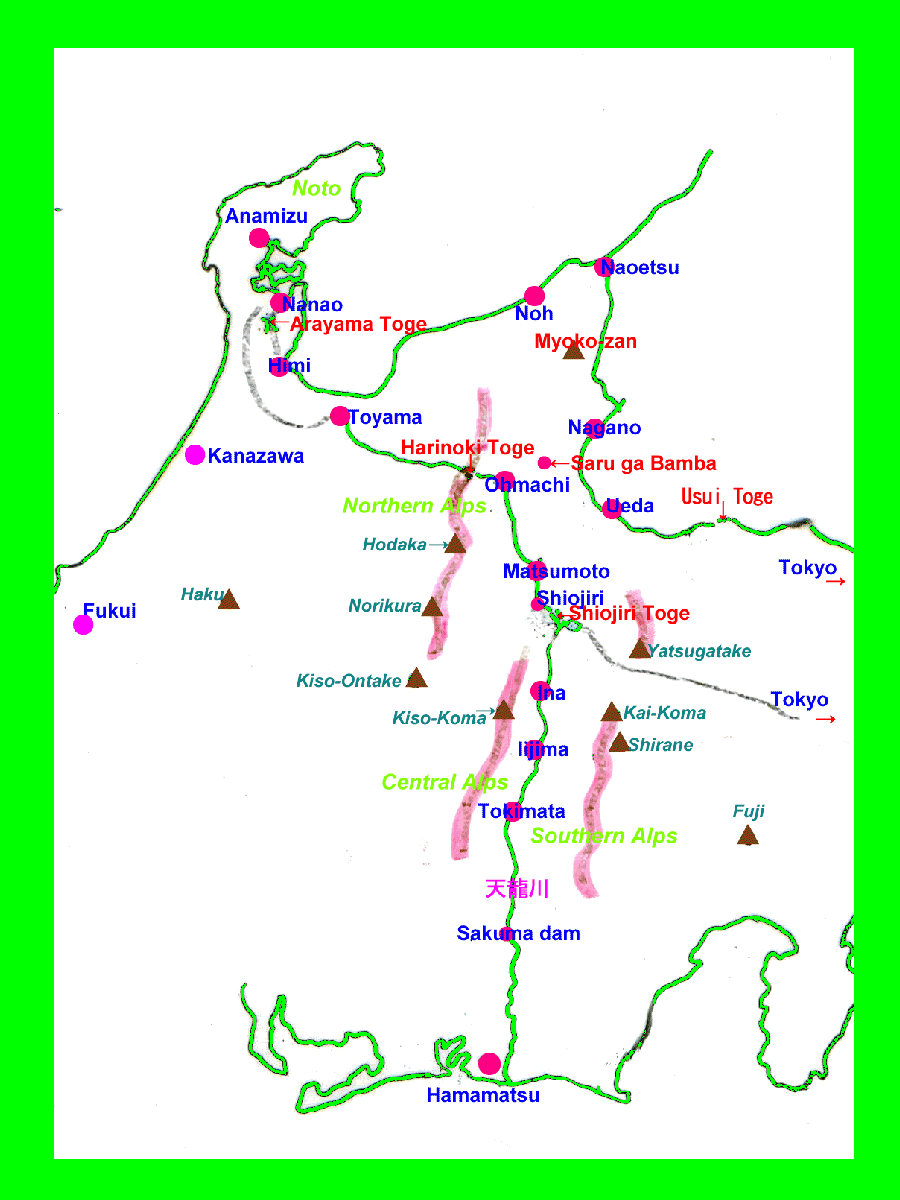 1゚ それより興味があるのは、歸路である。これも何時決定されたのであろうか。歸路の選擇は幾らか奇妙であり、どういう譯か「針ノ木峠」越えの企みであり、もしこれが成功すれば、佐々成政の「さらさら越え」を踏襲することになる。成政は新暦でいうと厳寒の一月2日に富山城を出て常願寺川を上り、蘆峅(あしくら)から湯川谷または立山下(りゅうざんじた)を經て「針ノ木峠」越えで大町に入り、多分天龍川沿いに下って濱松の家康を訪ねたとされるのである。利家に知られないように十日で濱松に達し、十日で戻る豫定が、片道だけで一ヶ月掛かる。村上昌己(Mk)氏はローヱルが成政の勇猛果敢を知っていたかどうか、訝っているが、地元では有名な話である上、多分ガイドブックに話があっただろうと思う。だから、ローヱルは湯川谷まで行って挫折したに拘わらず、「針ノ木峠」をサブタイトルにしているし、その後、どういうルートを取ったのか、塩尻に現れるまで、叙述は實に素っ氣ない(猿が馬場峠の邊りから描冩は開始されるが、何ともぎこちない)。塩尻以降詳しいのは針ノ木峠は失敗したが、天龍下りは豫定どおり決行したということであろう(譯では格好の旅程となっているが、ローヱルは豫め計畫した行程なのでと書いている。この譯には勝手譯があり、序でに述べるとその後で、「大きな星が一つ」、とあるが、これは原文では星は複數である)。ローヱルの富山での足跡は今後もう少し調べる必要があろう。
1゚ それより興味があるのは、歸路である。これも何時決定されたのであろうか。歸路の選擇は幾らか奇妙であり、どういう譯か「針ノ木峠」越えの企みであり、もしこれが成功すれば、佐々成政の「さらさら越え」を踏襲することになる。成政は新暦でいうと厳寒の一月2日に富山城を出て常願寺川を上り、蘆峅(あしくら)から湯川谷または立山下(りゅうざんじた)を經て「針ノ木峠」越えで大町に入り、多分天龍川沿いに下って濱松の家康を訪ねたとされるのである。利家に知られないように十日で濱松に達し、十日で戻る豫定が、片道だけで一ヶ月掛かる。村上昌己(Mk)氏はローヱルが成政の勇猛果敢を知っていたかどうか、訝っているが、地元では有名な話である上、多分ガイドブックに話があっただろうと思う。だから、ローヱルは湯川谷まで行って挫折したに拘わらず、「針ノ木峠」をサブタイトルにしているし、その後、どういうルートを取ったのか、塩尻に現れるまで、叙述は實に素っ氣ない(猿が馬場峠の邊りから描冩は開始されるが、何ともぎこちない)。塩尻以降詳しいのは針ノ木峠は失敗したが、天龍下りは豫定どおり決行したということであろう(譯では格好の旅程となっているが、ローヱルは豫め計畫した行程なのでと書いている。この譯には勝手譯があり、序でに述べるとその後で、「大きな星が一つ」、とあるが、これは原文では星は複數である)。ローヱルの富山での足跡は今後もう少し調べる必要があろう。( 圖は富山から大町までの予定の ルートを描いたもので、ローヱルは實際には、この道を「立山下」で断念 し、滑川に戻り最終的に長野の猿ヶ馬場峠に現れる。) |
| We ought to have taken warning from the general skepticism we met with at Toyama, when we proposed the pass. But with the fatal faith of a man in his guidebook, we ignored the native forebodings. |
|
尚、厳寒期は針ノ木峠は雪崩の多いところで、山男も避けたらしく、最近では成政もここを越えたのではなく、七倉澤から高瀬川沿いに下ったとされているようで、針ノ木峠は勇猛果敢傳説の象徴であろうと思う。冬のこの邊りは妖怪變化が棲むと言われることをローヱルも知っていて二度書いているようだが、要するにローヱルは妖怪に惑わされたというより、成政傳説に惑わされたという可能性が高い。尚、このルートはウエストンは數年後成功して、彼に皮肉られている。 |
| Our objective point was now the descent of the Tenriugawa rapids. It was not the shortest way home, but it was part of our projected itinerary and took us through a country typical of the heart of Japan. It began with a fine succession of passes. These I had once taken on a journey years before with a friend, and as we started now up the first one, the Saru ga Bamba no toge, I tried to make the new impression fit the old remembrance. But man had been at work upon the place without, and imagination still more upon its picture within. It was another toge we climbed in the light of that latter-day afternoon. |
|
2゚ 扨て、ローヱルは松本から塩尻に入り、ここで宿泊、次いで塩尻峠を越えて下諏訪に入り、郵便局へ寄ったあと、岡谷から天龍川に沿って伊那盆地に入り、箕輪、伊那と馬車で下って、飯島で泊まり、翌朝ここから舟に乗る。時又でもう一泊して、更に下って濱松に到るわけである。これは意思の堅いルートと思われる。尚、下諏訪は岐路であるが、ここはローヱルには馴染みの處という印象がある。
|
| …………. in front of us, came out the long outline of the Tokaido bridge, three quarters of a mile in length, like a huge caterpillar crawling methodically across the river-bed. Gradually we drew toward it, till its myriad legs glinted in the sunset glow; and then, as we swept under, it wheeled round to become instantly a gaunt stalking silhouette against the sky. |
 4゚ 先ず、七月末午前中に天龍川の河口近くの河川敷を走ったが、必要以上に廣く、「暴れ天龍」の面影はない。ローヱルの頃はもっと水量があったと思われ、ローヱルは舟で東海道線の鉄橋の下を潜っているが、實はこの鉄橋はローヱルの通ったと同じ1889年に掛けられ、静岡濱松間が開通しているから、その前後であると思う。
4゚ 先ず、七月末午前中に天龍川の河口近くの河川敷を走ったが、必要以上に廣く、「暴れ天龍」の面影はない。ローヱルの頃はもっと水量があったと思われ、ローヱルは舟で東海道線の鉄橋の下を潜っているが、實はこの鉄橋はローヱルの通ったと同じ1889年に掛けられ、静岡濱松間が開通しているから、その前後であると思う。川幅は天龍市に入ると適当になり、國道152號線を川に沿って氣持ちよく北上する。然し、473號線に入って給油所で佐久間ダムが不通ということを聞き、ここから151號線へ廻って山道となる。千メートル級の山稜が右眼下に聯なる風景で、この信州の山中でこの頃沖縄の伊舎堂(Id)氏から、新宿着、これから松本に向かう旨の電話が入ったが、午後三時頃であったろうか。ここから、とても國道とは思えない細い418號線で天龍村へ降り、再び川沿いの溯行となった。然し、十方峽等は樹陰でよく分からない。暫く縣道1號に沿い、83號線から國道151號線に戻り、天龍峽でまた東岸に出て、時又に着いた。


|
|
While I was still standing gazing at lessening Tokimata, I heard a cry from behind me, and, turning, ducked just in time to escape being unceremoniously somersaulted into the water by a hawser stretched from bank to bank at a level singularly suited to such a trick. The rope was the stationary half of a ferry to which I had neglected to make timely obeisance. It marked, indeed, an incipient stage in the art of suspension bridges, the ferryboat itself supporting a part of the weight, while the ferryman pulled it and himself across. We met several more in the course of the next few minutes, before which we all bowed down into the bottom of the boat, while the hawser scraped, grumbling impotently, overhead. Our boat was of adaptive build. It was forty-five feet long, not quite four feet wide, and somewhat over two feet deep. These proportions and the character of the wood made it exceeding lithe, so that it bent like a willow before necessity. In the stern stood the head man, wielding for rudder an oar half as long again as those the others used. There was very little rowing done, nor was there need; the current itself took us along at racing speed. Shortly after ducking under the last ferry rope we reached the gateway to the canon. Some rapids made an introduction, rocks in places jutting out of the foam, and while we were still curveting to the waves the hills suddenly closed in upon the stream in two beetling cliffs, spanned surprisingly by a lofty cantalever bridge. An individual who chanced to cross at the moment stopped in mid path to watch us through. The stream swept us in, and the countryside contracted to a vanishing vista behind. We were launched on our long canon voyage. The change was as sudden as a thunderstorm of a smiling summer afternoon. It was an eclipse of the earth by the earth itself. Dark rocks picketed with trees rose in still darker shadow on either hand, higher than one could see. The black river swirled beside us, silent, sullen, swift. At the bottom of that gorge untrodden by man, borne by the dark flood that untouched by sunlight coiled snakelike along, we seemed adventured on some unforgotten Styx. For some time we had voyaged thus with a feeling not unlike awe, when all at once there was a bustle among the boatmen, and one of them went forward and stood up in the bow. We swept round a corner, and saw our first great rapids three hundred yards ahead. We could mark a dip in the stream, and then a tumbled mass of white water, while a roar as of rage came out of the body of it. As we swept down upon the spot, the man in the bow began beating the gunwale with his oar in regularly repeated raps. The board gave out a hollow ring that strangely filled the river chasm; a sound well calculated to terrify the evil spirits of the spot. For indeed it was an exorcism of homoeopathic design. His incantation finished, he stood motionless. So did the rest of us, waiting for the plunge. The boat dipped by the bow, darted forward, and in a trice we were in the midst of a deafening turmoil of boiling waters and crashing breakers.The breakers laid violent hands upon us, grappling at the frail gunwale and coming in part aboard, and then, as we slipped from their grasp, impotently flung their spray in our faces, and with a growl dropped astern. The boat trembled like a leaf, and was trembling yet, when, with nightmare speed, the thing had slipped into the past, and we were shot out into the midst of the seething flood below. Not the least impressive part of the affair was the strange spirit-rapping on the bow. The boatmen valiantly asserted that this was simply for signal to the man in the stern. Undoubtedly now the action has largely cloaked itself in habit, but that it once was superstitious is unquestionable. Devils still constitute far too respected a portion of the community in peasant parts of Japan. The steering the boatmen did was clever, but the steering the stream managed of its own motion was more so. For between the rapids proper were swirls and whirlpools and races without end. The current took us in hand at the turns, sweeping us down at speed straight for a rock on the opposite bank, and then, just as shipwreck seemed inevitable, whisked us round upon the other tack. A thick cushion of water had fended the boat off, so that to strike would have been as impossible as it looked certain. And then at intervals came the roar of another rapid, like a stirring refrain, with the boatman in the bow to beat the time. So we swept on, now through inky swirls of tide, now through snow-capped billows, moods these of the passing stream, while above the grand character of the gorge remained eternally the same. |

5゚ 次はローヱルの最初に乗船した飯島だが、日岐(Hk)さんは元善光寺まで迎えに來てくれた。あとは楽チンで、まず飯島まで附いて行っただけである。飯島の街から乗り場まで可成りの距離があるとローヱルは書いているが、その通りで獨りでは迷い込みそうであった。Hk氏は役場に確かめて、船着き場のあった處を指された。然し、殘念ながら、宵が迫って、暗くなりかけて、あと伊那までHk氏のお陰で辿り着けたようなものである。途中、宮田(みやだ)でローヱルの馬車がぬかるんだところと、カーヴの多いところは、豫めHk氏に教えられていたので、車でも分かった。伊那に入ったときは眞っ暗で、濱松から八時間ほど掛かったであろうか。 |
| We had made arrangements overnight for a boat, not without difficulty, and in the morning we started in kuruma for the point of embarkation. We were eager to be off upon our voyage, else we should have strolled afoot down the long meadow slope, such invitation lay in it, the dew sparkling on the grass blades, the freshly tilled earth scenting the air, and the larks rising like rockets up into the sky and bursting into song as they went. It seemed the essence of spring, and we had a mile or more of it all before we reached the brink of the canon. For even here the river had begun a gorge for itself through the plain. We left our jinrikisha at the top and zigzagged on foot down the steep descent, and straightway departed the upper life of fields and larks and sunshine for a new and semi-subterranean one. It was not simply a change of scene; it was a complete change of sphere. The world with its face open to the day in a twinkling had ceased to be, and another world, a world of dark water girt by shadowed walls of rock and trees, had taken its place. |
 6゚ 翌日午前はHk氏と他のことで用事があり、午後、獨りで先ずもう一度飯島まで今度はローヱルの方向で走ってみた。ローヱルの馬車の通ったところは澤渡(さわんど)から下りは今の國道153號線と一致すると思うが、兩側遠くにアルプスが見えて、その中を上下しながら走ると舊い道だということがよく分かる。ローヱルは蒼い空と未だ冠雪のアルプス(當時は未だその名前はないが)を記述している。馬車の通行が止められたのは、Hk氏には多分大田切川の天龍への注ぎ口でぬかるんだからだということである。この川は木曾駒の方から雪解け水が流れるところで、上流はHk氏お奨めの駒ヶ根駒ヶ岳公園で、流れる水は冷たそうである。但し、駒ヶ根市は當時赤穂村である。幸い前日案内された道を降りることが出來、周りを探索出來た。尚、153號線は可成り當時のカーヴも含めて殘していると思う。朽ち掛かった橋というのは大田切川か、中田切川の橋(もう一本ある)だろうが、いまは何處の橋も頑丈である。
6゚ 翌日午前はHk氏と他のことで用事があり、午後、獨りで先ずもう一度飯島まで今度はローヱルの方向で走ってみた。ローヱルの馬車の通ったところは澤渡(さわんど)から下りは今の國道153號線と一致すると思うが、兩側遠くにアルプスが見えて、その中を上下しながら走ると舊い道だということがよく分かる。ローヱルは蒼い空と未だ冠雪のアルプス(當時は未だその名前はないが)を記述している。馬車の通行が止められたのは、Hk氏には多分大田切川の天龍への注ぎ口でぬかるんだからだということである。この川は木曾駒の方から雪解け水が流れるところで、上流はHk氏お奨めの駒ヶ根駒ヶ岳公園で、流れる水は冷たそうである。但し、駒ヶ根市は當時赤穂村である。幸い前日案内された道を降りることが出來、周りを探索出來た。尚、153號線は可成り當時のカーヴも含めて殘していると思う。朽ち掛かった橋というのは大田切川か、中田切川の橋(もう一本ある)だろうが、いまは何處の橋も頑丈である。 |
|
………… a rumor became current that the road had been washed away ahead, and that the basha would have to stop some miles short of where we had hoped to be that night. This was disheartening.……. The rumor gathered substance as we advanced, until in consequence we ceased to advance at all. At a certain village, called Miyada, the basha drew up, and we were informed that it was impossible to proceed further. ………………. The road ran along the skirts of the mountains on the right, which fell in one long sweep to the river, a breadth of plain unexpectedly gored by streams. The canons were startlingly abrupt, and the darkness which now came on took nothing from the effect. A sudden zigzag down to a depth of a hundred feet, a careful hitching over a decrepit bridge, and a zigzag up the other side, and we were off at a good trot again. This dispatch on the part of the men brought us in much-improved spirits and in very good time into Iijima, our hoped-for goal. |
|
7゚ この日は夕方に掛けて、伊那から更に伊北、辰野まで153號線を出來るだけ舊道で走り、辰野からローヱルが伊那盆地に入った處を探査した。多分現在縣道19號といわれるところが自然で、19號線はいい見晴らしをもたらす。ここから宮下から206號で川を越え、追分で153號線に合流したと思われる。これにはあとでHk氏も同意された。Hk氏の本家は木下で153號に面している。尚、伊那市などの153號線は古い地圖に見られない(添附の地圖は1921年製、日岐氏提供のものである)。伊那市から澤渡までの舊道は現在ひっそりとしている。
8゚ 翌日、Hk氏が兼ねてから調べてあった下諏訪温泉の「桔梗屋」を訪ねた。Hk氏は流石地元だから、桔梗屋さんと電話で道順を訊きながら、相槌が出來て、迷いもなく探し當てたのであるが、着くなりふたりとも、歡聲を上げた。 |
| We had started somewhat late, stopped for the lack of umbrella, and now were committed to a digression for letters I expected at Shimonosuwa. I never order my letters to meet me on the line of march but I bitterly repent having chosen that special spot. There is always some excellent reason why it turns out most inconvenient. |
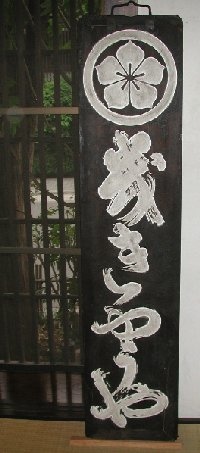 「桔梗屋」には後日、懇談會全員で押し掛けた。Mk氏などは矢張りこの諏訪の地理に明るい方だから、兩角さんと話が彈む。兩角さんはお祖父さんが町長であったとかで、お顔の廣いかたで、變光星の青木醫師などとも(多分公害問題で)お知り合いで、また琉球大の音楽の教授が諏訪のオペラに關してここを訪れるようで、沖縄のId氏と話が通じたりする。
「桔梗屋」には後日、懇談會全員で押し掛けた。Mk氏などは矢張りこの諏訪の地理に明るい方だから、兩角さんと話が彈む。兩角さんはお祖父さんが町長であったとかで、お顔の廣いかたで、變光星の青木醫師などとも(多分公害問題で)お知り合いで、また琉球大の音楽の教授が諏訪のオペラに關してここを訪れるようで、沖縄のId氏と話が通じたりする。なお、優雅な「幾きゃうや」の看板は部屋にもう一枚保存されていて、博物館にももう一枚在るそうである。ローヱルの写真のものとは少し字體が違っているので、博物館のがもっと舊いものであろう。桔梗屋の玄關内は和式の、筆者に言わせれば京都感覚の落ち着いたデザインであるが、割烹若旦那のOs氏も褒めていたように思う。一泊幾らだろうとあとで誰かが言っていたが、殘念ながら土建屋縣であるから、ダンプがしょっちゅう横を通るのは、氣の毒で、あとで筆者が能生で泊まったときも宿の前の8號線のトラックが五月蠅かったのと瓜二つである。下諏訪はこのあと町長に脱ダム派の人を選んだ。 9゚ 懇談會終了前日には、「桔梗屋」さんから塩尻峠を車で越えて、ローヱルが伊那谷に入る前に泊まった塩尻の脇本陣に向かった。ここは既にHk氏が一度訪ねて、ご當主の川上睦水氏にもお會いしている。そこで、勝手に庭に入って大勢で写真を撮ったりしていたところ、睦水氏がお出ましになり、いろいろ説明や案内をして下さった。
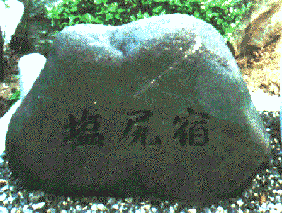
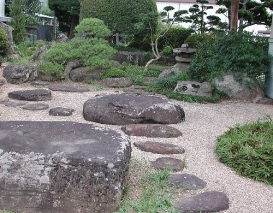 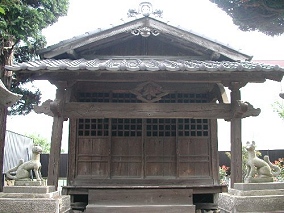
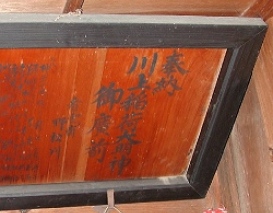 |
| The inn at Shiwojiri possessed a foreign table and chairs; a bit of furnishing from which the freshness of surprise never wore off. What was even less to be looked for, the son of the house was proficient in English, having studied with a missionary in Tokyo. I had some talk with him later, and lent him an English classic which he showed great desire to see. |
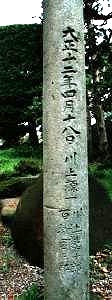 當時の脇本陣の建物は最早無く、百坪程の庭だけが殘る。ただ、奥に稲荷社が在るがこれは相當古いかも知れない(常夜燈には明和3年と刻まれているから、1766年である。正一位川上稲荷)。庭石は煤けて黒いのであるが、これは火災に依るようであり、ローヱルの前の明治15年(1882年)に火災にあっているらしく、その所爲のようである(越前朝倉遺跡の庭石も信長の焼き討ちにあっていまも黒く殘っているのに似ている)。だから、稲荷社も含めてこの庭はローヱルは見ているであろうと思われる。黒こげの中央の大きな石に天保十年(1839年)とあるから、この頃の作と言われている。ローヱルと英語で喋ったご先祖は川上源一といって、のち衆議院議員になるのだが、結局睦水氏の言に依れば選擧で財産を使い果たしたようである。現在のご當主睦水氏もご養子さんで、(源一さんもそうらしい)東大出身の工学博士のようだが、實は塩尻辨當の發明者で財を盛り返したようである。また、探検家で更に面白い話を伺ったが、CMO#264参照。
當時の脇本陣の建物は最早無く、百坪程の庭だけが殘る。ただ、奥に稲荷社が在るがこれは相當古いかも知れない(常夜燈には明和3年と刻まれているから、1766年である。正一位川上稲荷)。庭石は煤けて黒いのであるが、これは火災に依るようであり、ローヱルの前の明治15年(1882年)に火災にあっているらしく、その所爲のようである(越前朝倉遺跡の庭石も信長の焼き討ちにあっていまも黒く殘っているのに似ている)。だから、稲荷社も含めてこの庭はローヱルは見ているであろうと思われる。黒こげの中央の大きな石に天保十年(1839年)とあるから、この頃の作と言われている。ローヱルと英語で喋ったご先祖は川上源一といって、のち衆議院議員になるのだが、結局睦水氏の言に依れば選擧で財産を使い果たしたようである。現在のご當主睦水氏もご養子さんで、(源一さんもそうらしい)東大出身の工学博士のようだが、實は塩尻辨當の發明者で財を盛り返したようである。また、探検家で更に面白い話を伺ったが、CMO#264参照。
(CMOFukui 南 政 次)
|